When you’re traveling and you encounter a menu where you can’t understand single thing, do you a) make an attempt to communicate with the server with only four words you know of the local language , b) point at something in the menu and hope you don’t order something heinous, or c) try your luck in another restaurant with English translations in the menu? I’ve done all three: a) if I am feeling adventurous and , b) if I’m feeling extremely adventurous and c) when exhaustion dictates the need for something familiar and the the only adventure I want to have that day is figuring out the train route.

Golden roasted goodness in one of the windows of a restaurant in TST in Hong Kong
In the trip to Hong Kong, a place where good food is abundant, I found myself making all three decisions. In the mornings, when P and I are eager to start our day and before we meet with our friends, we wake up early and explore the nearby streets on our own from where we were staying.
On our second morning, we found ourselves in a crowded eatery (a cha chaan teng or tea restaurant) where people seemed to be taking their breakfasts in a hurry. As soon as we sat down, the server handed us a menu we couldn’t understand, but at least it had a couple of tiny photos of what looked like a bun, a bowl of noodle soup with meats on top, a plate of meat and a sandwich with what looked like luncheon meat. There was also a menu on a plastic holder with what seemed like set meals.
I was feeling a bit adventurous–hence the entry into the restaurant–but the set meals, which had what looked like noodle soup topped with luncheon meat (luncheon meat appeared everywhere) and had eggs and bread on the side, seemed like a big carb commitment. I pointed to what I hoped would simply be a piece of bread in the “bread section” (there was a bread photo on the side of the Chinese characters) and discreetly pointed to the milk tea on the neighboring table. My husband, who was ready to make a bigger breakfast commitment, pointed to a bowl of noodle soup. Our male server nodded and said, “Okay, offal.” And hurriedly disappeared.
We ended up with this: a roll of bread that turned out to be a pineapple bun (I did do a bit of homework on what to eat in Hong Kong) and which I was half-expecting to have a bit of pineapple flavor (didn’t do that much of a homework as pineapple buns I later found out got its named because it has a bit of resemblance to a pineapple…maybe I don’t see it because I took a quick bite as soon as it landed on the table; didn’t want to disappoint our brisk server!) and a noodle soup with offal. Oh, and since it’s a tea restaurant, we also got two glasses of tea. A friend would later tell me that some folks don’t dare drink the complimentary tea, but use it to clean their utensils.
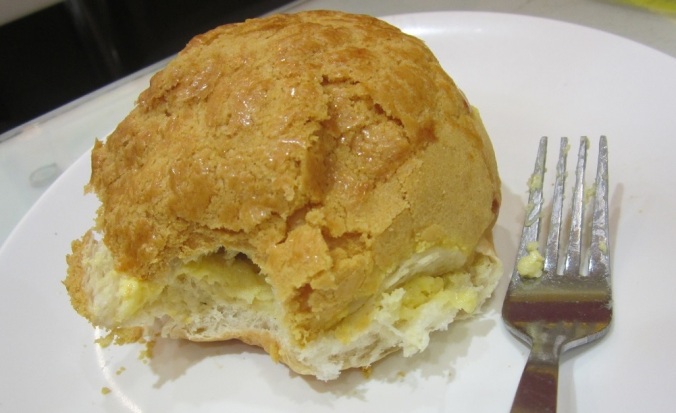
Pineapple bun with a slice of butter in between. I only liked the sweet, crunchy crust on top. And the butter.
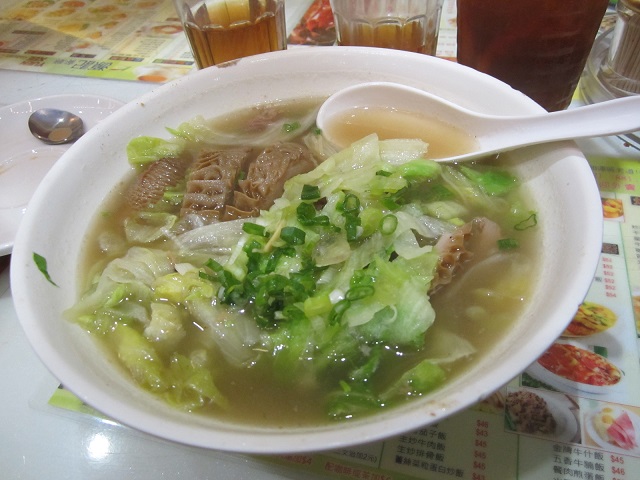
Yes! Organ meats in the morning! Good thing P liked it an offal lot
Our other breakfasts I’m afraid would be frowned upon by most intrepid travelers: McDonald’s and Yoshinoya. There was something comforting about feeling lost in a city and having something familiar. Or the fact that it was just cold and we didn’t want to walk any further to look for a resto. In my defense, I did try something unfamiliar in the Japanese chain–a soupy rice dish with different kinds of overcooked mushrooms on top. Yes, it’s as awful as it sounds.
There are a lot of good Japanese food in Hong Kong though and we took advantage of it on our first few meals. Finally, P and I got to try Ippudo Ramen (Silvercord Tower along Canton Road) and Coco Ichibanya (Windsor House, Gloucester Road, Causeway Bay; across the building with an Ikea and HMV). Yes, international chains, again. But who am I to ignore ramen and Japanese curry?
It almost sounds like sacrilege that our first meal in chilly Hong Kong–the land of steaming wonton noodle soup, beef brisket and congee–was a bowl of Japanese ramen, but there it was, welcoming us with its tonkotsu miso goodness, firm noodles, juicy char siu and perfectly cooked egg. And if you’re craving for Japanese curry, the ones at Coco Ichibanya (the top curry rice chain in Japan) hit the spot.
While I had a list of local Hong Kong restaurants I did want to try, the one on top of the list was Tim Ho Wan. Ever since it got a Michelin star in 2009 and earned the title as the cheapest Michelin star resto in the world, visitors to Hong Kong have been lining up outside its branches. There were three, the newest one to open is in Central (beneath IFC mall), one in Sham Shui Po and the first branch in Mongkok (which when we visited HK had already closed, reportedly due to high rent).
We went to the branch in IFC. Pros: shorter line and easier to find. Con: this wasn’t the branch that earned the Michelin star. While there was a chance we wouldn’t get Michelin-grade dim sum (which I honestly have no idea how to judge), my friends and I still hoped we would get to taste some good dim sum.
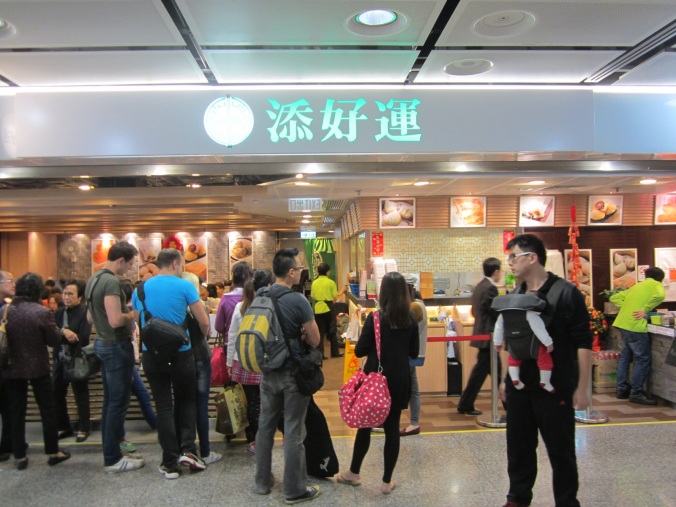
We couldn’t read the sign but we realized it was Tim Ho Wan, not just for the number of people waiting for a table, but for the framed clippings on the wall
We arrived around 1 pm at the IFC branch and had to wait for at least 40 minutes. Most blogs I’ve read indicate that you need to know Cantonese when you line up at Tim Ho Wan (was I going to attempt option a?), but this isn’t the case. You get a number and you only have to hang around near the woman who calls the number (make sure your group is complete when she calls) and if you don’t understand her, just discreetly keep showing her the number you have in your hand. It worked for us non-Cantonese speaking tourists.
There’s also an English menu in THW and while we waited, our group of six happily ordered all the dim sum we wanted to try. I think we ended up ordering a total of 16 plates and baskets of dim sum. After around 40 minutes of waiting, our party of six were crammed into a table for four. There wasn’t enough real estate on our table for all the dim sum we ordered, which ended up being piled on top of one another. You could imagine all six sets of arms, hands, and chopsticks crisscrossing each other to pick up a dumpling.
THW’s popular item, the baked bun with barbecued pork filling was as good as advertised–sugar-crusted on top (similar to a pineapple bun), delicate and fluffy dough, and sweet and savory filling.
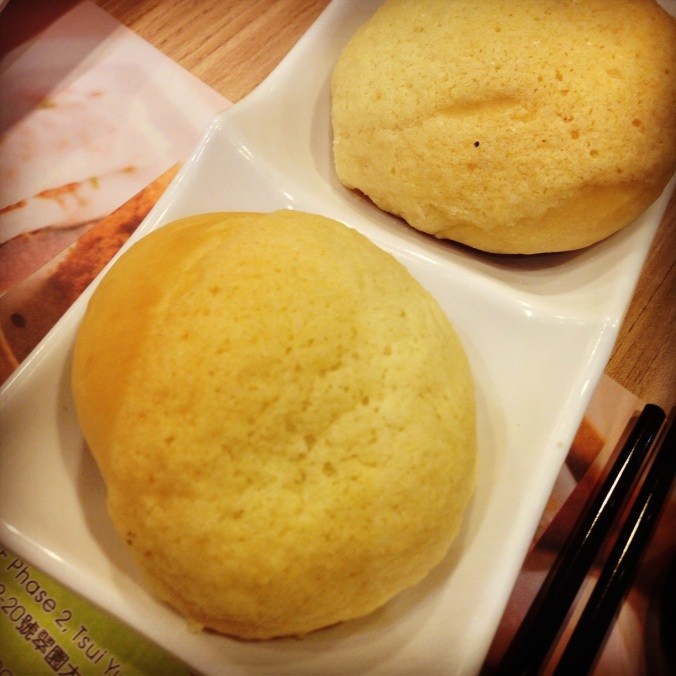
Tim Ho Wan’s famed baked bun with barbecued pork
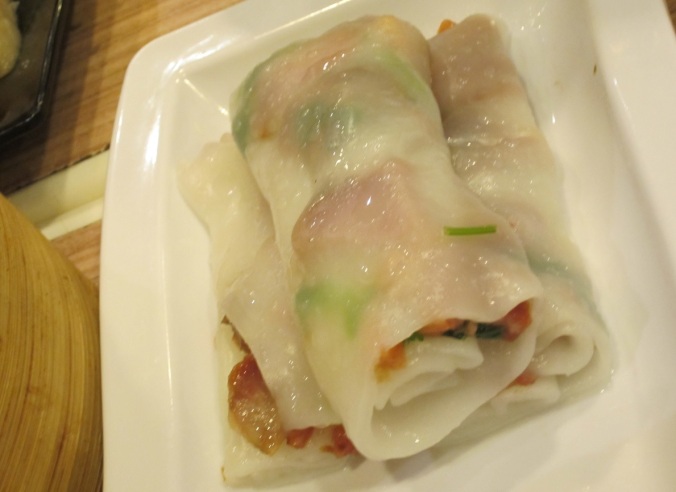
Stuffed vermicelli roll
Another memorable dish was the stuffed vermicelli rolls. We ordered the different kinds (there was one stuffed with shrimp, another stuffed with pig’s liver, and another I couldn’t recall), but what I remember clearly was how the soft rice noodle roll didn’t fall apart upon being picked up with chopsticks as most rice rolls are prone to do at least in many of the Chinese restos here in Manila. I also loved how plump the shrimps were in the rice rolls and fresh shrimp dumplings. Most of the dim sum are good (the chicken feet was the only disappointment for my friend Terrie), all of them cheap (HKD10 to HKD20). And it made for a satisfying almost sublime Hong Kong lunch on a budget. And I didn’t even have to use the four local words I knew.
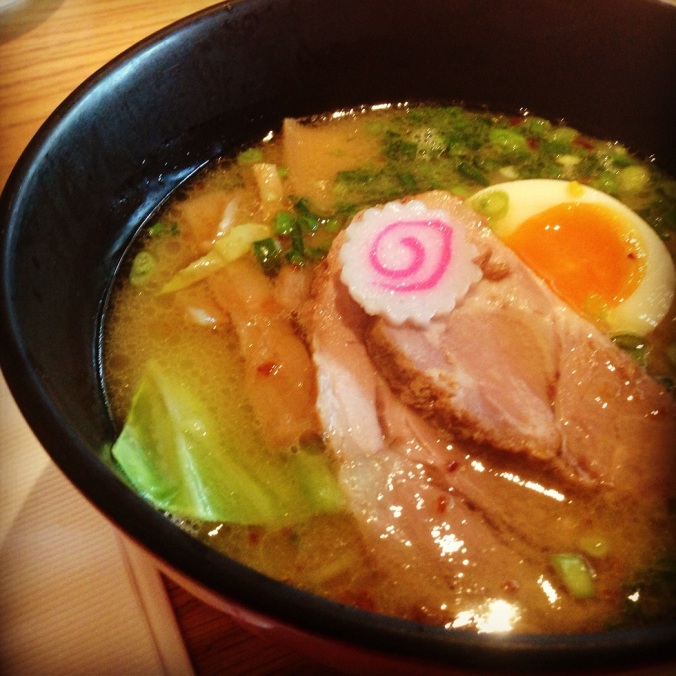
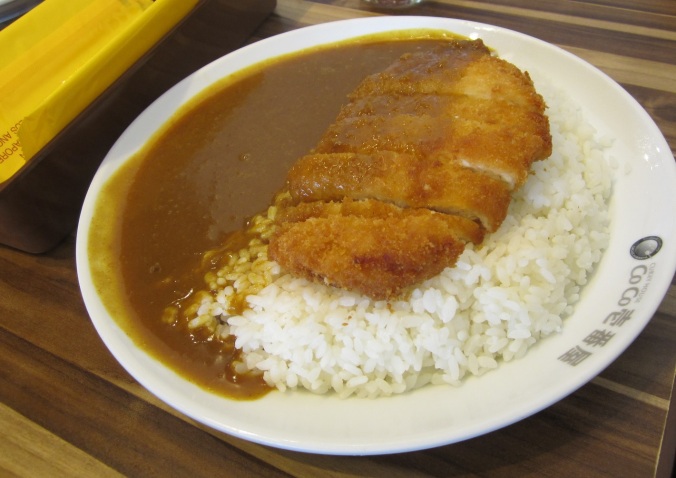
On a recent trip I was so tired I settled for a McDonalds. You can’t go wrong with something familiar 😉
Oohhh! Pork cutlet curry rice and all of that lovely Hong Kong food! I want some now!
No you can’t! Though sometimes they end up not being the best meal you can have 🙂 Just came back from a quick out-of-town trip wherein our first meal was in a local fast food chain because we only had a short time to spare and we knew we would get our food in X number of minutes. It wasn’t the greatest, but it prevented me from biting my companions’ heads off from hunger. 😉
looks like you got some good eats covered especially by stopping off at a classic cha chan Tang. Was it Tsui Wah?
Next time you can catch-up on the BBQ meats like the roast port, goose, & pigeon along with the congee and noodles. Although, the Phillipines has some pretty authentic Chinese food as well, no?
You’re gonna laugh but on my last visit to HK, I went to Jollibee near Central.
Hi Pat, tbh I don’t know the name of the cha chan tang…it only had a Chinese sign which I couldn’t read, tsk, tsk.
I did get to try some roast goose and pork (no pigeon, I have never eaten pigeon, come to think of it…) one night in HK but my friends and I demolished the spread before any camera phones were whipped out for ‘Instagramming’ 😉 mental note: should have more roasted meats next time. and yes, you’re right about the Phils. having some authentic Chinese food since there’s a pretty big Chinese-Filipino population here. A lot of the local Filipino foods are even heavily influenced by Chinese dishes (aside from Spanish). A visit to the capital’s Chinatown (Binondo) is the surest way to get a taste of it.
Haha, Jollibee in HK! How did you find it? Was there sweet Filipino-style spaghetti? 🙂
I don’t think it was Tsui Wah then. The english name is pasted all over and thinking about it again, the menu is in chinese and english, I believe. Tsui Wah seems to be a very popular chain in HK since I bumped into it on numerous occassions on Hong Kong Island and Kowloon.
I want to make my way over to the Philippines one day. Though I’ve heard the weather there is pretty darn hot! A friend said, if I thought HK was hot – think again! When I visited HK, I started to miss the winters in NJ/NYC?!
I was just combing the streets by Central and in a little alleyway, I saw Jollibee! I think I remember seeing spaghetti on the menu but I was concentrating on the fried chicken and halo halo! I first discovered Jollibee through some filipino friends when visiting them in California and then a jollibee finally opened up in New York some years ago. I didn’t realize Jollibee was a chain that was created in the philippines. In Jersey City, NJ there is also a Max’s Chicken that I have yet to try. I’ve also heard that this is a popular resto in the Phils?
Yes, you should visit the Philippines! 🙂 It can get a bit chaotic (just part of the adventure, hehe) but there are a lot of lovely places (heritage site, beaches…) and yes, it can also get pretty damn hot. Just a few days ago, the temperature reached 38degrees C, and it was humid, ugh. You’ll probably miss winters there in your neck of the woods all over again. Best to visit from December to Feb when it is cooler.
Yah, Jollibee chicken joy is the most popular item on their menu (the Filipino spaghetti is more of an acquired taste, hehe), and the chicken in Max’s is also a must-try. The resto opened after the war and it was a big hit with American soldiers and from there it became such a big chain. Okay enough,restaurant history lesson, I’m getting hungry 🙂
The secret didn’t last long. When former Lung King Heen chef Pui Gor opened this hole-in-the-wall joint in Mong Kok, those in the know flocked here for top-quality Hong Kong dim sum at rock-bottom prices.
Haha! i come from hk, a reli interesting article about the cha chann teng in hk. Actually, you can find a lot of delicious local food there=)
Hi Angela, thanks for reading! I think I barely scratched the surface with the amount of great food in HK! I hope I can go back and try some more delicious local food 🙂